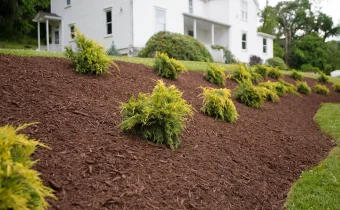There is no shortage of lawn predators out there looking to tear up your lawn. Lawn diseases can come in and cause huge patches of brown turf that must be removed. Pests can even chew up turf blades to the point of no return. On top of that, weeds can look nearly identical to your turf, and take over before you even know it. The heat of the summer could even cause drought conditions and a need for rehabilitation. As you can see there are so many reasons why you might need to put down some new seed. While in the past you may have gone straight to traditional seeding, there is now a better way. Let’s compare hydroseeding vs traditional seeding.

What is Hydroseeding?
This “better way” that we refer to is in fact, hydroseeding. It has become increasingly popular for good reason, and you may have heard of it. Hydroseeding is a liquid seed application, where a slurry contains a mix of seed, paper fiber mulch, starter fertilizer, and water as additives to guarantee healthy initial growth. It is known for preventing soil erosion, as a big knock on traditional seeding is that those seeds are subject to the will of mother nature. Because of the slurry application, seeds stick straight to the ground as well as the other additives.
Benefits of Hydroseeding
While the primary benefit of hydroseeding is that soil erosion is no longer a concern, you might be looking for a catch. In actuality, hydroseeding beats out traditional turf in almost every metric. Hydroseeding has been proven to result in healthier lawns because it increases the moisture retention of the seeds, is less costly than traditional seeding, and can be applied literally anywhere. It can be performed on any property from a flat lawn to a steep hill.
Hydroseeding actually maintains longer seed-to-soil contact and the only initial maintenance it requires is frequent watering. The root system produced is deep and healthy, and is aided by erosion matting. Another benefit of hydroseeding is the opportunity to use erosion matting to control the growth of your seeds in hard-to-seed areas. This removes the need for straw or hay, as the slurry will bond to your soil, and then grow up through the matting in a uniform manner. With less seed discharge and infiltration due to the nature of the installation, you can expect a healthier lawn for a lower cost.

Downsides of Traditional Seeding
We do not expect you to blindly believe that traditional seeding is no good, so let us tell you why. When it comes to hydroseeding vs traditional seeding, firstly, it is more expensive than hydroseeding. Thus, in order to ever be worth it, traditional seeding must perform better in most categories. This is simply not the case. Because seed is applied loosely over your soil, there are no organic additives already present to bind the seed to the soil. You will have to fertilize, water, and watch your seed until it begins to grow. It will also be subject to the elements, flying or washing away at the first feeling of wind or rain.
You also run the risk of weed seed infiltrating your dry seed, which is a common occurrence. It will also take about two months to establish – which is a bit longer than hydroseeding. Overall, hydroseeding is the better option, and you will see a decline in traditional seeding over time. Get ahead of the trends and invest in hydroseeding services for your new lawn.
Dream Greener Lawn & Landscape is led by a staff of service experts, each with ten years or more of professional experience, focused exclusively on lawn care & maintenance, landscaping, and snow & ice management. Locally owned and operated, we are proud to serve the greater Pittsburgh area. Give us a call at (412) 835-1035 or visit our website today.



